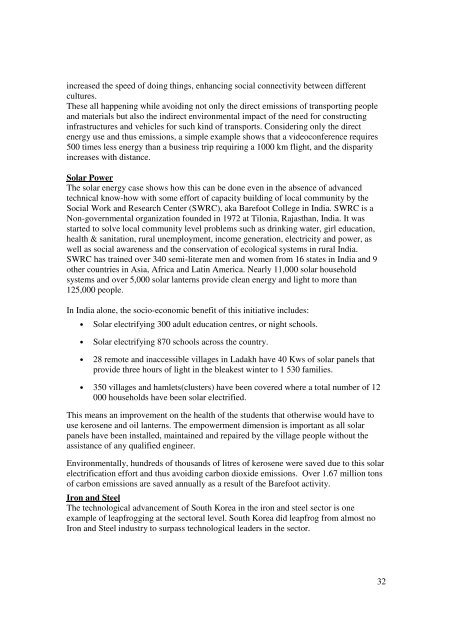Leapfrogging Possibilities For Sustainable Consumption and ...
Leapfrogging Possibilities For Sustainable Consumption and ...
Leapfrogging Possibilities For Sustainable Consumption and ...
You also want an ePaper? Increase the reach of your titles
YUMPU automatically turns print PDFs into web optimized ePapers that Google loves.
increased the speed of doing things, enhancing social connectivity between different<br />
cultures.<br />
These all happening while avoiding not only the direct emissions of transporting people<br />
<strong>and</strong> materials but also the indirect environmental impact of the need for constructing<br />
infrastructures <strong>and</strong> vehicles for such kind of transports. Considering only the direct<br />
energy use <strong>and</strong> thus emissions, a simple example shows that a videoconference requires<br />
500 times less energy than a business trip requiring a 1000 km flight, <strong>and</strong> the disparity<br />
increases with distance.<br />
Solar Power<br />
The solar energy case shows how this can be done even in the absence of advanced<br />
technical know-how with some effort of capacity building of local community by the<br />
Social Work <strong>and</strong> Research Center (SWRC), aka Barefoot College in India. SWRC is a<br />
Non-governmental organization founded in 1972 at Tilonia, Rajasthan, India. It was<br />
started to solve local community level problems such as drinking water, girl education,<br />
health & sanitation, rural unemployment, income generation, electricity <strong>and</strong> power, as<br />
well as social awareness <strong>and</strong> the conservation of ecological systems in rural India.<br />
SWRC has trained over 340 semi-literate men <strong>and</strong> women from 16 states in India <strong>and</strong> 9<br />
other countries in Asia, Africa <strong>and</strong> Latin America. Nearly 11,000 solar household<br />
systems <strong>and</strong> over 5,000 solar lanterns provide clean energy <strong>and</strong> light to more than<br />
125,000 people.<br />
In India alone, the socio-economic benefit of this initiative includes:<br />
• Solar electrifying 300 adult education centres, or night schools.<br />
• Solar electrifying 870 schools across the country.<br />
• 28 remote <strong>and</strong> inaccessible villages in Ladakh have 40 Kws of solar panels that<br />
provide three hours of light in the bleakest winter to 1 530 families.<br />
• 350 villages <strong>and</strong> hamlets(clusters) have been covered where a total number of 12<br />
000 households have been solar electrified.<br />
This means an improvement on the health of the students that otherwise would have to<br />
use kerosene <strong>and</strong> oil lanterns. The empowerment dimension is important as all solar<br />
panels have been installed, maintained <strong>and</strong> repaired by the village people without the<br />
assistance of any qualified engineer.<br />
Environmentally, hundreds of thous<strong>and</strong>s of litres of kerosene were saved due to this solar<br />
electrification effort <strong>and</strong> thus avoiding carbon dioxide emissions. Over 1.67 million tons<br />
of carbon emissions are saved annually as a result of the Barefoot activity.<br />
Iron <strong>and</strong> Steel<br />
The technological advancement of South Korea in the iron <strong>and</strong> steel sector is one<br />
example of leapfrogging at the sectoral level. South Korea did leapfrog from almost no<br />
Iron <strong>and</strong> Steel industry to surpass technological leaders in the sector.<br />
32
















